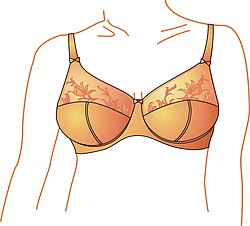There are many brassiere designs suitable for a wide variety of business and social settings and to wear with a variety of outer clothing. The bra's shape, coverage, functionality, fit, fashion, fabric, and color can vary widely. Some bras are designed to offer basic, practical support and coverage while others are purposefully sexual, sensual, or revealing. [1]
Contents
Manufacturers' bra designs and styles constantly change. There is no standardized system for categorizing bras, and they are made in a wide variety of designs, including those listed here and others like bridal bra, plus size bra, vintage bra, leather bra, and belly dance bra. [2] [3] Many bras fulfil more than one purpose, like a balconette bra made of sheer material.












